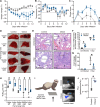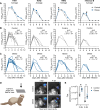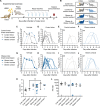Diet-induced obesity affects influenza disease severity and transmission dynamics in ferrets
- PMID: 38728395
- PMCID: PMC11086619
- DOI: 10.1126/sciadv.adk9137
Diet-induced obesity affects influenza disease severity and transmission dynamics in ferrets
Abstract
Obesity, and the associated metabolic syndrome, is a risk factor for increased disease severity with a variety of infectious agents, including influenza virus. Yet, the mechanisms are only partially understood. As the number of people, particularly children, living with obesity continues to rise, it is critical to understand the role of host status on disease pathogenesis. In these studies, we use a diet-induced obese ferret model and tools to demonstrate that, like humans, obesity resulted in notable changes to the lung microenvironment, leading to increased clinical disease and viral spread to the lower respiratory tract. The decreased antiviral responses also resulted in obese animals shedding higher infectious virus for a longer period, making them more likely to transmit to contacts. These data suggest that the obese ferret model may be crucial to understanding obesity's impact on influenza disease severity and community transmission and a key tool for therapeutic and intervention development for this high-risk population.
Figures






Update of
-
Diet-induced obesity impacts influenza disease severity and transmission dynamics in ferrets.bioRxiv [Preprint]. 2023 Sep 26:2023.09.26.558609. doi: 10.1101/2023.09.26.558609. bioRxiv. 2023. Update in: Sci Adv. 2024 May 10;10(19):eadk9137. doi: 10.1126/sciadv.adk9137. PMID: 37808835 Free PMC article. Updated. Preprint.
References
-
- Petersen A., Bressem K., Albrecht J., Thieß H.-M., Vahldiek J., Hamm B., Makowski M. R., Niehues A., Niehues S. M., Adams L. C., The role of visceral adiposity in the severity of COVID-19: Highlights from a unicenter cross-sectional pilot study in Germany. Metabolism 110, 154317 (2020). - PMC - PubMed
-
- Pugliese G., Liccardi A., Graziadio C., Barrea L., Muscogiuri G., Colao A., Obesity and infectious diseases: Pathophysiology and epidemiology of a double pandemic condition. Int. J. Obes. (Lond) 46, 449–465 (2022). - PubMed
Publication types
MeSH terms
Grants and funding
LinkOut - more resources
Full Text Sources
Other Literature Sources
Medical
Research Materials

